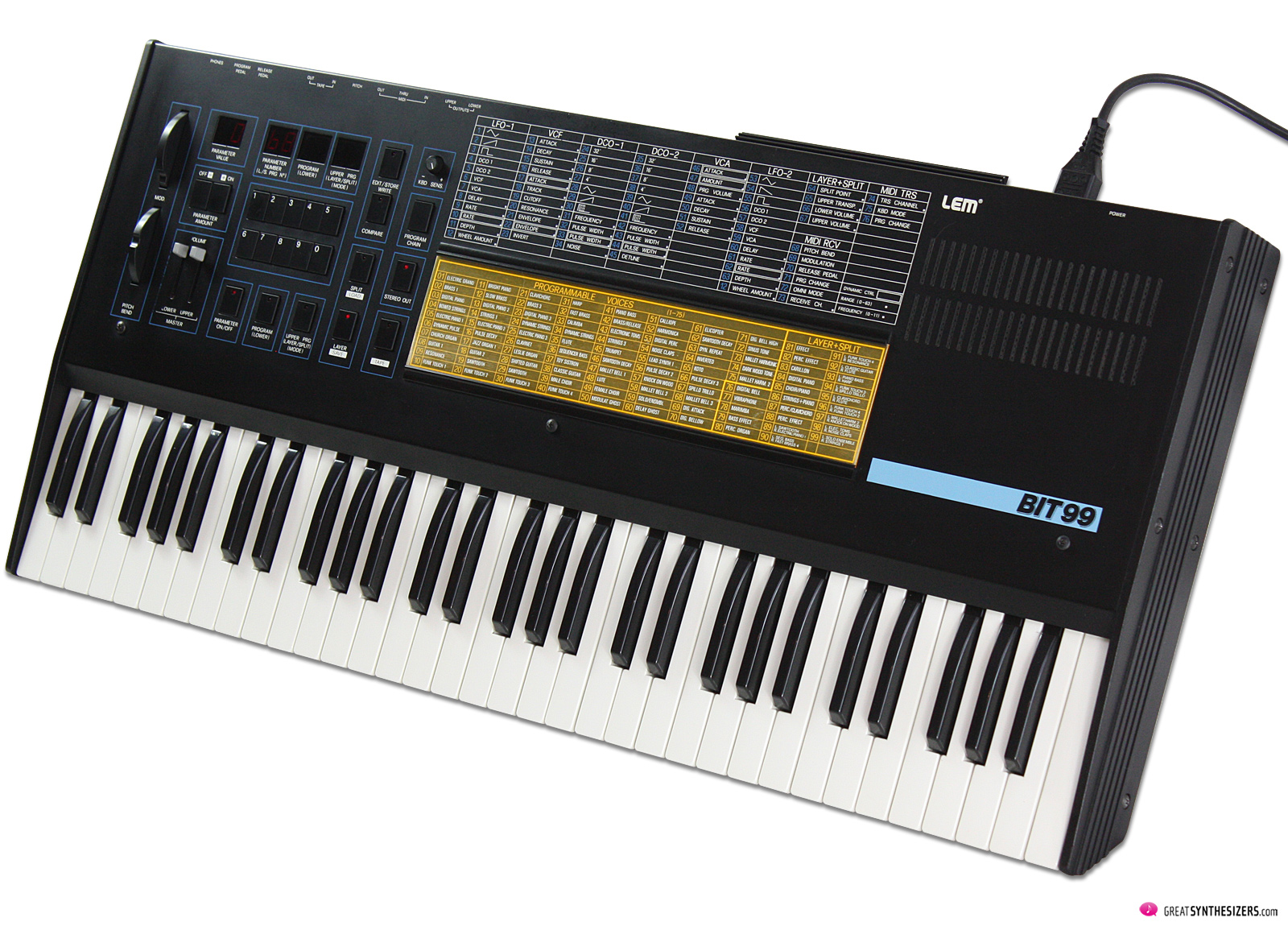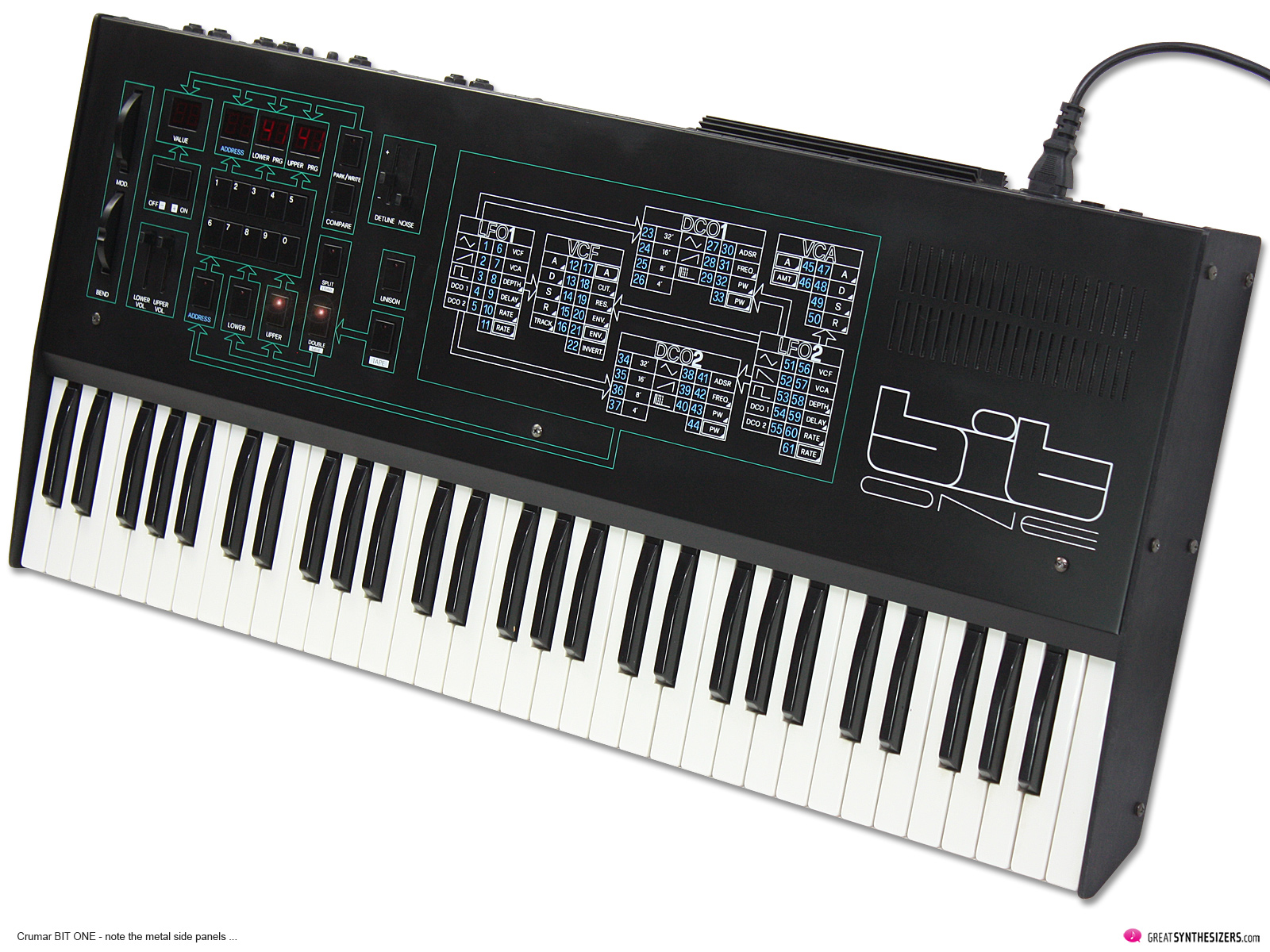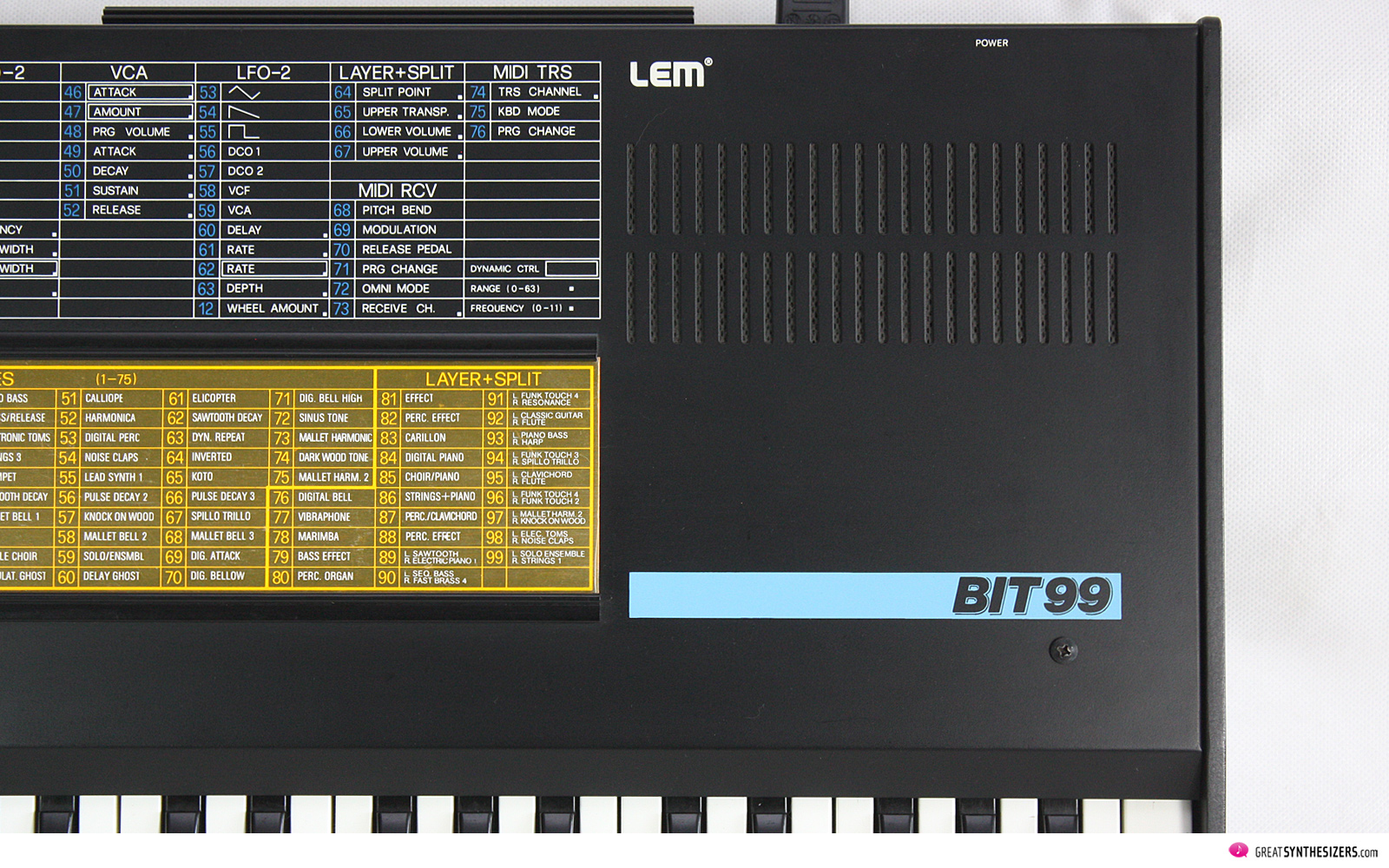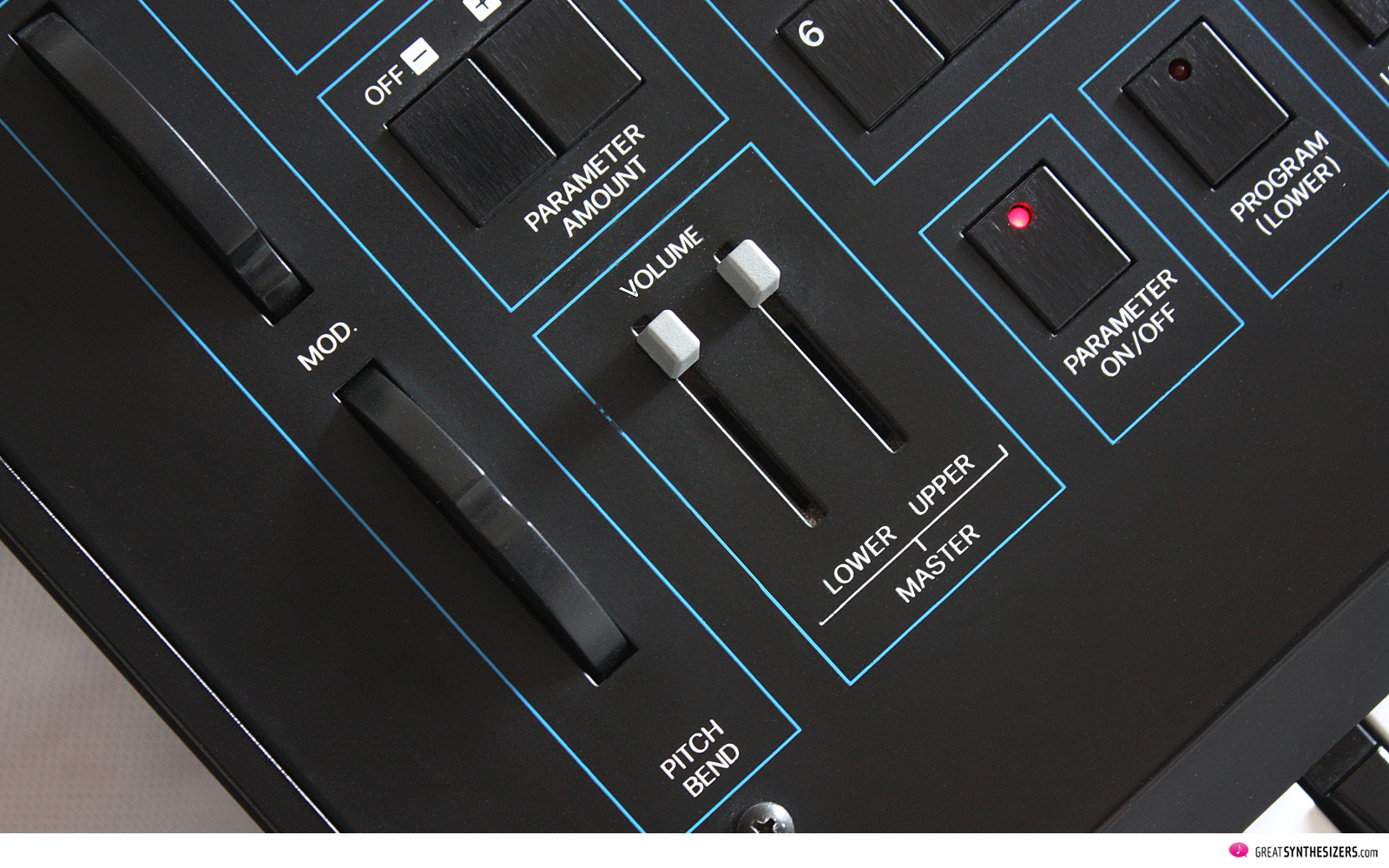These Crumars are not among the poly-analog synthesizers that have found a permanent place in the Valhalla of vintage instruments. They are unspectacular in appearance, their characteristic acoustic is rarely heard on the charts, their artistic legacy will probably never be significant. And yet, they have musical class, creating expressive sounds that even famous contemporaries – legends such as the Roland Jupiter-8 or the Sequential Prophet-5 – have not been capable of.
We’re talking about Crumar BIT ONE, BIT 99 and BIT 01, which livened up the low-budget synth market between 1984 and 1988. To be clear: A BIT is certainly not a Jupiter … and not a Prophet. That’s not the point. But: The BIT ONE / BIT 99 / BIT 01 have a dynamic expressivity and special sound characteristics that – let’s be honest here – you won’t find in any of the big, classic synthesizers.
In reality, there’s no justification for comparing the BIT instruments with those classics, due to their individual architecture (DCOs, velocity and MIDI). The fact is: Some synthesizers have gone down as legends, while other synthesizers have only made it to a marginal note in music history. If you listen to BIT ONE / BIT 99 / BIT 01 bass sequences or lead lines today, you may ask yourself: “Why? Were is the insignificance here?”
A brief history of the BIT family
In the mid-1980s, Crumar brought a whole series of semi-professional MIDI instruments onto the market. The BIT ONE, released in 1984, was the first of the new synth generation. According to synth literature, Luciano Jura was the chief designer. And Mario Maggi had a hand in it, which comes as no surprise, considering parallels to his glorious Elka Synthex.
The BIT ONE, released in two filter revisions – SSM2044 and CEM3328 respectively – had 6 analog voices (12 DCOs), MIDI, program memory, a velocity sensitive keyboard, stereo outputs and smooth metal side panels. Unison, detune control and noise control were among its extra extras. It was in production for just a year, and it was only available in black.
Although the BIT ONE had a slightly bigger sound than the later BIT 99 / BIT 01 (especially through UNISON mode), it had several weak points. Split / layer sound combinations could not be saved. DETUNE and NOISE were not progammable. Its MIDI functions were poor and the keyboard was immediately disconnected once you attached a cable to MIDI IN … either you played the BIT ONE or you controlled it via MIDI. You couldn’t have both!
Whilst there is a BIT ONE MIDI Upgrade from HKA Design now in 2023 that fixes the aforementioned shortcomings (and – surprise, surprise – includes an onboard arpeggiator!), we’ll leave the BIT ONE aside and focus on its successors which had essentially the same sound and were in line with the standards of a modern MIDI studio right from the beginning …
In 1985, the BIT 99 replaced the BIT ONE. It featured 24 memory locations for split / layer sounds, PRG CHAIN (3 chains à 33 sounds), improved MIDI, expanded split/layer/stereo functions and programmability for DETUNE / NOISE, while continuing in the CEM3328 filter tradition. It had ripped plastic side panels and was available in black and white, as was its rack version BIT 01.
The BIT 01 – already to be pronounced in 1984 – was originally intended as a rack expander of the BIT ONE (including unison and those additional faders, see the gaphic below). But ultimately, in 1985, it became the expander of the BIT 99 and thus the BIT 01 as we know it today …
1985 also saw the release of the BIT MMK (MIDI Master Keyboard), featuring 6 octaves, VEL and AT, and a built-in sequencer. With this control center of your entire MIDI universe (LOL), the Crumar instrument family including BIT ONE, BIT 99, BIT 01 and BIT MMK was complete.
Since Crumar had a considerable distribution network not only in Europe but also in the USA, the BIT instruments were available under several names. UNIQUE (to our knowledge, the US-distributor in North America) launched the BIT 99 as UNIQUE DBK (keyboard), the BIT 01 as UNIQUE DBE (expander) and the BIT MMK as UNIQUE DBM (masterkeyboard).
Another major Crumar distributor was CHASE in the UK:
“The largest UK synthesizer importer and distributor (aka The London Synthesizer Centre) in the late seventies and early to mid eighties, Chase re-badged Crumar, Jen and BIT products […].”
(Peter Forrest, A-Z Of Analogue Synthesisers, Part One A-M, page 60)
However, regarding its aggressive advertising campaigns, it is doubtful whether CHASE has contributed much to the reputation of BIT synthesizers or not.
“In Britain, the instruments were distributed by a flash-in-the-pan outfit called Chase Musicians, who delighted in preposterously hyped marketing and absurd price slashes (“Originally $3 million, now only 50 bucks!” – that type of thing).”
(Julian Colbeck, Keyfax Omnibus Edition, page 12)
As if BIT, UNIQUE and CHASE weren’t enough names for Crumar, a fourth company came into play in Italy: LEM. LEM took over Crumar in 1987, continuing production of BIT instruments until 1988. So this gave us the names LEM BIT 99, LEM BIT 01 and LEM BIT MMK as well. Not to forget that masterkeyboard in the rare “weighted” version, developed by LEM themselves, named LEM MMK weighted (see this Reverb auction of July 2023). *
[ * Whether LEM was already producing for Crumar before the takeover is not entirely clear. Our two LEM BIT 99, for example, have a Crumar nameplate. And the above mentioned LEM MMK weighted was already in production in 1986. So the cooperation might have been in full swing before 1987. ]
Back to 1987/1988. While at that time BIT synthesizers with their outdated analog technology were still being built in Southern Europe, the Japanese digital bestsellers Roland D-50 Linear Arithmetic Synthesizer (1987) and the Korg M1 AI Synthesizer/Workstation (1988) were appearing on the market. Calling this “The meeting of two worlds” would be a massive understatement … the difference in synthesizer technology between Europe and Japan could hardly have been greater!
Nevertheless – and this brings the short BIT history to a conclusion – Crumar BIT ONE, BIT 99 and BIT 01, of which several thousand were produced, were respectable synthesizers in their day. From the viewpoint of 1984, they were modern and solidly processed. They have resisted the ravages of time (to a large extent) up til now and cut a great figure – another understatement – as quality analog poly-synthesizers with MIDI in the studio setup of the year 2023!
CRUMAR BIT 99 / BIT 01 – appearance and architecture
It seems strange that a company located in Italy – THE world-class nation in terms of industrial and fashion design – would produce synthesizers with an appearance more reminiscent of devices in industrial kitchens (or medical laboratories) than of musical instruments. The BIT 99, especially, is a real challenge to the eye. The unconditionally flat panel, the strange wheel arrangement, the boring color scheme (in the common “black” BIT version), the visually dull (as well as technically imprecise) switches, and those imprinted signal path graphics (making it seem more complicated than it is) – all this contributes to the instrument’s unattractive appearance.
On the other hand, that exaggerated-pimped, pseudo-technical appearance of the BIT instruments could bring tears of joy to the eyes of the admirers of the 80s! What a successful bad style, what a masterstroke! And if you turn away – fascinated and repelled at the same time – from the BIT 99 towards the BIT 01, it’s almost disappointing that the expander version appears more aesthetically balanced. In any case, the smaller (and more precise) push buttons of the BIT 01 are without a doubt a real blessing in practise. Here, one gratefully and gladly takes note of the change.
Main feature of BIT 99 / BIT 01:
- 6 voices
- 2 DCOs per voice (waveforms: triangle, sawtooth and pulse wave, all waveforms can be activated simulanesouly, noise is also available)
- 1 VCF per voice (CEM 3328 filter)
- ADSR envelope for the VCF
- ADSR envelope for the VCA (or possibly “the” VCAs, since the sounds can be stereo)
- 2 global VC LFOs (waveforms: triangle, sawtooth and square)
- 99 program memories (75 single sounds and 24 split/double combinations)
- Cassette interface, MIDI and velocity control
Dynamic control functions (Velocity / MIDI):
- Pulse width of both oscillators
- VCF (ADSR amount)
- VCA (Volume amount)
- ATTACK-TIME of both envelopes
- LFO RATE of both LFOs
The BIT factor: Expressivity
We probably have to be more specific: The BIT factor – the very unique selling point of these instruments – was their expressivity in combination with that typical sound generation.
Controlling the BIT instruments – the BIT SOUND (!) – via velocity / MIDI allows for synthesizer soli and musical textures of unexpected uniqueness. Provided you take a few hours and adapt the already good (but by no means spectacular) presets to your own needs and playing style. Which is indeed a bit tedious, since usability and programming were the instrument’s weakest points.
However, those few hours (or those few weekends) of programming will definitely be worth it. You can add beats and interesting modulations (2 LFOs) to the sound, adjust the transitions in the attack times (via velocity / MIDI), increase the filter resonance (and thus lend to the sounds a vaguely indefinable flavor), whatever …
Once you’ve perfected the presets, you’ll have those sounds at your dispolsal for years / decades. And you will use them with pleasure, because in their own BIT way they are timeless (!) analog sounds that will find their justification in numerous musical projects.
SOUND
BIT 99 / BIT 01 are known for their bass sounds and electronic sequences. In addition, you can create convincing analog pads with filter sweeps and brilliant strings with amazingly long attack times. Drum sounds (bass drum, electronic toms hi-hat) and effect sounds of the simpler kind (in the sense of or lively dual LFO modulations and FM-effects – LFO with 250Hz) are also an integral part of the BIT repertoire. Not to forget those funky clavinet / e-piano / organ / brass presets – snappy envelopes! – that are a pure joy to play …
But probably most convincing are those excellent lead sounds with nuanced velocity modulation and great dynamics. Possibly only a BIT synthesizer can achieve such sounds (given: we haven’t tried all keyboards on this planet …). Within the BIT family, the BIT 99 with its light-weight, yet sensitive keyboard is our favorite. It allows you to create soli with enormous dynamic range. These soli have more the feel of a natural than of an electronic instrument – including harmonics, side noises and “dropouts”. The BIT 99: A wind instrument. The BIT 99: A string instrument.
Sound sample Xtra: BIT 99 – Free-Solo demonstrates the dynamic and acoustic possibilities of a BIT 99 performed à la natural instrument. And check out the precise keyboard reaction of the BIT ONE on this Youtube Video!
SPLIT / LAYER and STEREO mode are other notable assets of the BIT architecture. In LAYER mode, polyphony is reduced to 3 voices – we just have to live with that – but nevertheless, since many sounds (basslines, leadlines etc.) are used monophonically, the powerful LAYER feature is a real benefit. Press STEREO and those LAYER sounds get even bigger! And when deactivating SPLIT / LAYER and thus returning to a single sound, STEREO sends the audio alternately right and left … which is what you can hear in most of the attached soundfiles.
Let’s move on to the filter. The CEM 3328 may have its commited supporters, but it certainly also has its commited opponents. At high filter resonance, the BIT sound gains a somewhat tinny timbre – especially at mid / high frequencies. Whether this anomaly is due to the filter chip or the odd oscillator architecture (additive squarewave synthesis) is beyond us.
Be it as it may: Those tinny timbres create a rather cheap impression and do not represent the crème de la crème of analog sound art. In this light, BIT 99 / BIT 01 filter movements will never reach the pure elegance of filter sweeps found on a Jupiter-8, Prophet-5, Oberheim OB-X/Xa/8 etc. But on the other hand, that tinny timbre can add a special color to certain BIT sounds that is perfectly suitable for lead lines and brasses, enhancing the instrument’s unconventional and natural character.
Let’s take a brief look at the oscillators. The two DCOs offer triangle, sawtooth and pulse. Some or all of the waveforms can be selected simultaneously, yielding mixed tone colors and thus extra sound variations in a small scale. Pulse Width Modulation is a bit of a surprise. While it can be controlled via keyboard / velocity / MIDI, which is great, PWM via LFO (there are two LFOs on board) is not possible. Then again, you can help yourself by performing the modulation manually. Select parameter PULSE WIDTH, press “+” or “-” and imitate slow LFO-to-PWM movements with your fingers. Since that’s a bit cumbersome, you can also send adequate velocity data to the BIT, simulating LFO-to-PWM movements via MIDI.
Taken as a whole, the SOUND of BIT 99 / BIT 01 offers a remarkable spectrum – from warm and broad to strong and assertive, whereby the massiveness is partly due to the DCOs. These – perfectly tuned – deliver a powerful signal. The oscillator’s digital control, on the other hand, is responsible for their directness – there are no beatings here! Thus, you’re obliged to add liveliness – if required – and program beatings on your own. Again, for example, with the two LFOs …
But then, the instrument’s slightly clinical sound is not the point! The symbiosis of powerful DCOs and expressive performance possibilities (MIDI, velocity, stereo) puts sound potential at your disposal that makes the BIT synthesizers unique.
BIT 99 versus BIT 01
Why MIDI control of a BIT 01 does not deliver the same results as gigging the BIT 99 keyboard live is beyond us! We have tested many different set-ups and even purchased the BIT MMK master keyboard – 6 octaves (!) – to control the BIT 01 and the BIT 99, but found no way to recreate the agility of a lively played BIT 99. Does the hardly measable latency of MIDI make the difference?
It’s exactly the BIT 99 (and, of course, the BIT ONE) that allows for those brilliant live sessions. At first glance, the light-weighted plastic keyboard seems a bit cheap, but in fact it forms a perfect symbiosis with the sound architecture. Thus, it’s via the BIT 99 (BIT ONE) keyboard only that BIT synth soli achieve their maximum in dynamics and expressivity.
For this reason, the Crumar BIT 99 (and BIT ONE with enhanced MIDI) is the be-all and end-all to us. That’s a very personal assessment, of course, based on our individual way of making electronic music (prefering keyboards over rack synths).
Musicians and studios around the globe, on the other hand, often give preference to the BIT 01. Thanks to its compact size (rack unit!) and better operability (smaller, yet more precise buttons), the BIT expander is the more sought-after instrument these days.
Stereoping Controller, Tauntek Upgrade and (free) BIT Software Synth
For better tweakable of BIT ONE / BIT 99 / BIT 01, there is now an external hardware available: The Stereoping Synth Controller CE-1. It allows free access in real time by means of 16 knobs.
In order for this to work, your BIT synthesizer still needs to be equipped with the new BIT ONE / BIT 99 / BIT 01 Tauntek Firmware. See Bob Grieb’s website for more information …
Then, there’s the Bucket ONE, child of the never tiring Full Bucket Music platform (many thanks to Andy for pointing this out). Bucket ONE is a free software synthesizer (Windows or MacOS):
The Bucket ONE is a software synthesizer plug-in for Microsoft Windows (VST2/VST3/CLAP) and Apple macOS (VST2/VST3/AU/CLAP) simulating the classic Crumar BIT 01/99 synthesizers from 1985. It is written in native C++ code for high performance even on “lighter” systems. Main features are:
- Close simulation of the original hardware
- Visual sound editor
- Up to 64 voices polyphony including Split and Double mode
- Two oscillators with three waveforms (triangle, sawtooth, pulse)
- Additional white noise generator
- Classic self-resonating four-pole lowpass filter
- Individual envelopes for VCF and VCA
- Two low frequency oscillators (LFOs)
- Supports MTS-ESP by ODDSound dynamic micro-tuning
- Resizable user interface (not “N” version!)
- MIDI Learn – all parameters can be controlled by MIDI CC
- Plug-in supports Windows and macOS (32 bit and 64 bit)
BIT reliability and service
In our experience, BIT 99 / BIT 01 are reliable and stable instruments. We have a BIT ONE (CEM filter version), six BIT 99 and two BIT 01 (one of which has always been kept for spare parts). All models that worked at the time of purchase are still up and running 10 or 20 years later.
Every now and then the CR2032 battery needs to be replaced (not a big deal). And rarely – very rarely – a BIT needs to be restarted because of bad tuning (which is a big exception). Beyond that, there are no major complaints to date …
But of course, several shortcomings still exist. The two VOLUME faders of BIT 99 / BIT 01 are of mediocre quality, they sometimes crack terribly (contact cleaning is required), causing audio dropouts every now and then.
Other weak areas: The BIT 99’s large switches are clumsy and often lack an exact action point. Shipping or moving the instrument, its keys can easily break, as can the plastic side panels. And the rear jack sockets also tend to disintegrate unexpectedly, breaking in their axis (we experienced it three times).
This may all sound dramatic, but in reality it’s not. Service effort on the BIT 99 / BIT 01 is low. We conclude that the BIT 99 shouldn’t be moved too much (best if it doesn’t leave the studio at all). Its somewhat impractical shape of the chassis and its exposed keys / side panels do not allow any mistake when handling.
If transportation is unavoidable, a custom-fit BIT 99 hard case is what you need (a soft case would not be sufficient). That hard case is also indispensable for storage: Due to its strange shape, a BIT 99 placed on edge will tip over at the slightest vibration.
Second-hand market
The best has been saved for last: Price! BIT synthesizers are still relatively cheap on the second hand market. Both the BIT 99 keyboard and the BIT 01 expander are traded in price regions between 600 and 1,500 USD / Euros. That’s moderate for a 6-voice analog synthesizer with MIDI, velocity-keyboard and split/layer/stereo modes. The BIT 01 – representing the more professional instrument in a MIDI studio – is much sought-after. Since it was built in smaller numbers, the BIT expander slowly mutates to a vintage rarity, with an expected increase in prices over the long term.
The currently friendly prices of BIT synthesizers should be seen in a larger context. What does a Roland Jupiter-8 cost today? (It costs twenty times as much as a BIT 99 … But does it sound twenty times as good …?”) What does an Oberheim OB-X cost? Astronomical sums are demanded for certain vintage synths just because they are legends. A BIT 99 / BIT 01 – that marginal note in music history – is a friendly response to this madness. The inconspicuous Italo-synthesizer is not only cheap, it also stands up to the famous bolides in terms of sound – in its very own way.
Bottom line
Crumar BIT 99 and BIT 01 (and, of course, BIT ONE with upgraded MIDI specs) are excellent analog synthesizers that stand up to comparison with many great classics in synth history. Obviously, the BITs have their architectural shortcomings: Osc-Sync and Ring-Mod are just as much in vain as Sample & Hold and sophisticated modulation options. Not to mention the uninspiring BIT access! These instruments were not designed for live tweaking, their poorly equipped control panel requires a lot of patience in the process of sound optimization.
And yet: Elaborately programmed BIT patches guarantee expressive lead lines, bass lines and synth sequences that are – surprise, surprise – unparalleled in synth history. Whether the BITs are gigged live or via MIDI: Their musical results can be stunning! In addition, their technical reliability is in the acceptable range, their service effort low. We therefore advise to make a quick grab as long as the second-hand prices of BIT 99 / BIT 01 (and BIT ONE) are a bargain.
In a nutshell: These gems of expressivity not only have their own sound character and musical expression, they also belong to those vintage poly synthesizers that are still affordable in 2023.
Well worth a recommendation.
x
50+ minutes of audio files are attached. As a supplement to the sound samples, we linked three BIT 99 Youtube videos. They all illustrate the great sound of the instrument. The fourth video is a short demo of the HKA Design BIT ONE MIDI and arpeggiator upgrade …
Crumar BIT ONE / BIT 99 / BIT 01
Polyphonic analog synthesizers
(1984 – 1988)
6 Voices (12 DCOs) with CEM3328 Filters, 2 ADSR, 2 global VC LFOs,
SPLIT/DOUBLE Sounds, Stereo Outs, Velocity and MIDI
Dimensions / Weight:
Crumar BIT ONE / BIT 99 Keyboard:
86 x 40 x 8 cm; 13,2 kg
Crumar BIT 01 Expander:
19 inch rack, 3 HU; 7,9 kg
Open / Download:
Crumar BIT 99 / LEM Photo 1 (4000 x 2600 px)
Crumar BIT 99 / LEM Photo 2 (4000 x 2600 px)
Crumar BIT 99 / White and Black (4000 x 2600 px)
Crumar BIT 01 / UNIQUE DBE (4000 x 2600 px)
Links:
(New) Crumar Website
Stereoping Synth Controller CE-1
BIT 99 article from 1985 (www.muzines.co.uk) (1)
BIT 99 article from 1985 (www.muzines.co.uk) (2)
HKA Design – Crumar BIT ONE MIDI + arpeggiator upgrade
Tauntek – New Firmware (MIDI CC Control) for BIT ONE / 99 / 01
Youtube Videos:
BIT 99 demo by The Himer
BIT 99 demo by deepsonic.ch
BIT 99 Demo by Cartong Music
BIT ONE Demo by Harry Axten / HKA Design (MIDI Upgrade / arpeggiator demo)














































Bjorn from Full Bucket Music has just released a VST instrument that simulates the Bit99, he’s called it Bucket One.
Any chance you could check it out and see how it compares to the originals?
… hello Andy. Honestly, I don’t use any plugins in the studio (and therefore won’t be able to test the software). But certainly I’ll add both the info and the link to the test report. Many thanks for the note! Regards – Theo
You missed to say that Crumar Bit One and I think also Bit 99/01 was designed by Mario Maggi, the Elka Synthex designer!
… hello Fabio … you’re right. I hesitated a little, but will add the information to the article. Best wishes – Theo